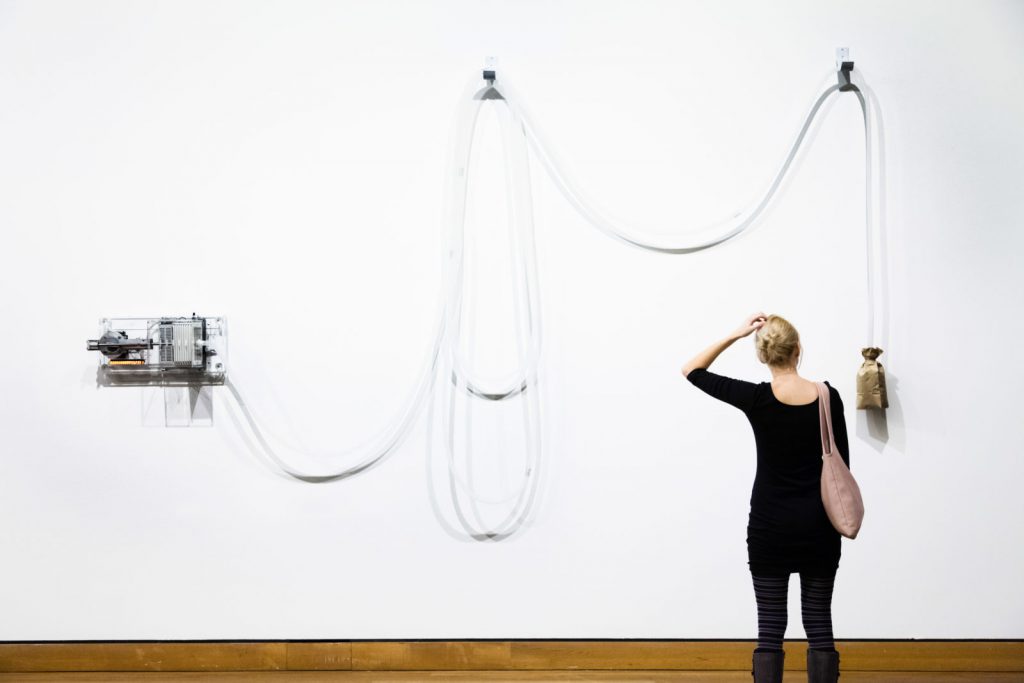
Published December 12, 2014
In the early years of the 20th Century, the arts entered a period of revolution. Enough of the escapism, the modernists said. Art must show modern life as it is. Only in that way can it offer real consolation. Ornament is crime, declared the architect Adolf Loos, and all those baroque facades that line the streets of Vienna, encrusted with meaningless knobs and curlicues, are so many denials of the world in which we live. They tell us that beauty belongs in a vanished past. In the face of this message, Loos set out to discover a purer beauty – beauty that belongs to modern life and also endorses it.
Loos’s contemporary Arnold Schoenberg rebelled against the late romantic music of which he was such a master, saying that tonal music had become banal, and that writing in the old way led to musical cliches. Schoenberg proceeded to reinvent the language of music, hoping to recover the purity and precision of Mozart or Bach. Eliot and Pound rebelled against the fairy-tale poetry of Housman and Walter De La Mare. The task of the poet, they insisted, was not to provide nostalgic dreams but to wake us up to reality. True poetry shows things as they are, and the poet’s frame of reference must be rebuilt in order to make this possible. The result will not be easy to understand. But, unlike the escapist poetry of the Victorians, it will be worth understanding.
In the attacks on the old ways of doing things one word in particular came into currency. That word was “kitsch”. Once introduced, the word stuck. Whatever you do, it mustn’t be kitsch. This became the first precept of the modernist artist in every medium. In a famous essay published in 1939, the American critic Clement Greenberg told his readers that there are only two possibilities available to the artist now. Either you belong to the avant-garde, challenging the old ways of figurative painting, or you produce kitsch. And the fear of kitsch is one reason for the compulsory offensiveness of so much art produced today. It doesn’t matter that your work is obscene, shocking, disturbing – as long as it isn’t kitsch.
Nobody quite knows where the word “kitsch” came from, though it was current in Germany and Austria at the end of the 19th Century. Nobody knows quite how to define the word either. But we all recognize kitsch when we come across it. The Barbie doll, Walt Disney’s Bambi, Santa Claus in the supermarket, Bing Crosby singing White Christmas, pictures of poodles with ribbons in their hair. At Christmas we are surrounded by kitsch – worn out cliches, which have lost their innocence without achieving wisdom. Children who believe in Santa Claus invest real emotions in a fiction. We who have ceased to believe have only fake emotions to offer. But the faking is pleasant. It feels good to pretend, and when we all join in, it is almost as though we were not pretending at all.
The Czech novelist Milan Kundera made a famous observation. “Kitsch,” he wrote, “causes two tears to flow in quick succession. The first tear says: How nice to see children running on the grass! The second tear says: How nice to be moved, together with all mankind, by children running on the grass!” Kitsch, in other words, is not about the thing observed but about the observer. It does not invite you to feel moved by the doll you are dressing so tenderly, but by yourself dressing the doll. All sentimentality is like this – it redirects emotion from the object to the subject, so as to create a fantasy of emotion without the real cost of feeling it. The kitsch object encourages you to think, “Look at me feeling this – how nice I am and how lovable.” That is why Oscar Wilde, referring to one of Dickens’s most sickly death-scenes, said that “a man must have a heart of stone not to laugh at the death of Little Nell”.
And that, briefly, is why the modernists had such a horror of kitsch. Art, they believed, had, during the course of the 19th Century, lost the ability to distinguish precise and real emotion from its vague and self-satisfied substitute. In figurative painting, in tonal music, in the cliche-ridden poems of heroic love and mythic glory, we find the same disease – the artist is not exploring the human heart but creating a puffed-up substitute, and then putting it on sale.
Of course, you can use the old styles, but you cannot seriously mean them. And if you use them nevertheless, the result will be kitsch – standard, cut-price goods, produced without effort and consumed without thought. Figurative painting becomes the stuff of Christmas cards, music becomes spineless and sentimental, and literature collapses into cliche. Kitsch is fake art, expressing fake emotions, whose purpose is to deceive the consumer into thinking he feels something deep and serious, when in fact he feels nothing at all.
However, to avoid kitsch is not so easy as it looks. You could try being outrageously avant-garde, doing something that no one would have thought of doing and calling it art – perhaps trampling on some cherished ideal or religious feeling. But as I argued last week, this way also leads to fakes – fake originality, fake significance, and a new kind of cliche, as in so much Young British Art. You can pose as a modernist, but that won’t necessarily lead you to achieve what Eliot, Schoenberg or Matisse achieved, which is to touch the modern heart in its deepest regions. Modernism is difficult. It requires competence in an artistic tradition, and the art of departing from tradition in order to say something new.
This is one reason for the emergence of a wholly new artistic enterprise, which I call “pre-emptive kitsch”. Modernist severity is both difficult and unpopular, so artists began not to shun kitsch but to embrace it, in the manner of Andy Warhol, Allen Jones and Jeff Koons. The worst thing is to be unwittingly guilty of producing kitsch. Far better to produce kitsch deliberately, for then it is not kitsch at all but a kind of sophisticated parody. Pre-emptive kitsch sets quotation marks around actual kitsch, and hopes thereby to save its artistic credentials. Take a porcelain statue of Michael Jackson cuddling his pet chimpanzee Bubbles, add cheesy colours and a layer of varnish. Set the figures up in the posture of a Madonna and child, endow them with soppy expressions as though challenging the spectator to vomit, and the result is such kitsch that it cannot possibly be kitsch. Jeff Koons must mean something else, we think, something deep and serious that we have missed. Perhaps this work of art is really a comment on kitsch, so that by being explicitly kitsch it becomes meta-kitsch, so to speak.
Or take Allen Jones, whose art, currently on display at the Royal Academy, consists of female lookalikes contorted into furniture, dolls with their sexual parts made explicit by underwear, vulgar and childishly nasty visions of the human female, the whole as frothy with fake sentiment as any simpering fashion model. Again the result is such obvious kitsch that it cannot be kitsch. The artist must be telling us something about ourselves – about our desires and lusts – and forcing us to confront the fact that we like kitsch, while he pours scorn on kitsch by laying it on with a trowel. In place of our imagined ideals in gilded frames, he offers real junk in quotation marks.
Pre-emptive kitsch is the first link in a chain. The artist pretends to take himself seriously, the critics pretend to judge his product and the modernist establishment pretends to promote it. At the end of all this pretence, someone who cannot perceive the difference between the real thing and the fake decides that he should buy it. Only at this point does the chain of pretence come to an end, and the real value of this kind of art reveals itself – namely its money value. Even at this point, however, the pretence is important. The purchaser must still believe that what they buy is real art, and therefore intrinsically valuable, a bargain at any price. Otherwise the price would reflect the obvious fact that anybody – even the purchaser – could have faked such a product. The essence of fakes is that they are not really themselves, but substitutes for themselves. Like objects seen in parallel mirrors they repeat themselves ad infinitum, and at each repetition the price goes up a notch, to the point where a balloon dog by Jeff Koons, which every child could conceive and some could even manufacture, fetches the highest price ever paid for a work by a living artist – except, of course, that he isn’t one.
So what, then, is the real thing? How do we tell the real work of art and the fake apart, and why does it matter? This will be my topic for next week.
— Roger Scruton is a senior fellow of the Ethics and Public Policy Center








